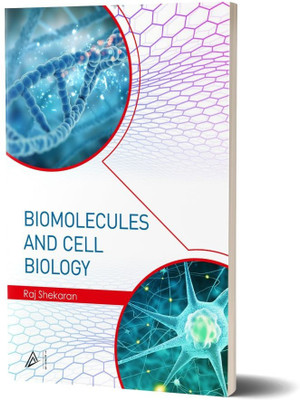Biomolecules and Cell Biology(Paperback, Dr. Raj Shekaran)
Quick Overview
Product Price Comparison
Biomolecules; Types and Significance of Chemical Bonds; Structure and Properties of Water; pH and Buffers; Carbohydrates: Nomenclature and classification; Role of Monosaccharides (, fructose, sugar alcohols-mannitol and sorbitol); Disaccharides (sucrose, maltose, lactose); Oligosaccharides and Polysaccharides (structural-cellulose, hemicelluloses, pectin, chitin, mucilage; storage - starch, inulin); Isomers and derivatives of glucose, and Acid; Lipids: Definition and major classes of storage and structural Lipids; Storage lipids: Fatty acids structure and functions; Essential Fatty Acids; Triacyl Glycerols structure, functions and properties; Saponification Structural lipids; Phosphoglycerides: Building blocks, General structure, functions and properties; Structure of phosphatidylethanolamine and phosphatidylcholine; Sphingolipids: building blocks, structure of sphingosine, ceramide; Lipid functions: cell signals, cofactors, prostaglandins; Introduction of lipid micelles, monolayers, Bilayers; Proteins: Structure of amino acids; Peptide bonds; Levels of protein structure-primary, secondary, tertiary and quarternary; Isoelectric point; Protein denaturation and biological roles of proteins; Nucleic acids: Structure of nitrogenous bases; Structure and function of nucleotides; Types of nucleic acids; Structure of A, B, Z types of DNA; Types of RNA; Structure of RNA; Bioenergenetics; Laws of Thermodynamics; Concept of Free Energy; Endergonic and exergonic reactions, coupled reactions, redox Reactions; ATP: Structure, its role as a energy currency molecule; Enzymes; Structure of Enzyme: holoenzyme, apoenzyme, cofactors, coenzymes and prosthetic group; Classification of enzymes; Features of active site, substrate specificity, mechanism of action (activation energy, lock and key hypothesis, induced-fit theory); Michaelis-Menten equation, enzyme inhibition and factors; affecting enzyme activity; The Cell; Cell as a unit of structure and function; Characteristics of prokaryotic and eukaryotic Cells; Origin of eukaryotic cell (Endosymbiotic theory); Cell Wall and Plasma Membrane; Chemistry, structure and function of Plant Cell Wall; Overview of membrane function; fluid mosaic Model; Chemical composition of membranes; Membrane transport - Passive, active and facilitated transport, endocytosis and exocytosis; Cell Organelles; Nucleus: Structure-nuclear Envelope; Nuclear pore complex; Nuclear lamina, molecular organization of chromatin; Nucleolus; Cytoskeleton: Role and structure of microtubules, microfilaments and intermediary filament; Chloroplast, mitochondria and peroxisomes: Structural organization; Function; Semiautonomous nature of mitochondria and chloroplast; Endomembrane system; Endoplasmic Reticulum - Structure, targeting and insertion of proteins in the ER, protein folding; Processing and quality control in ER, smooth ER and lipid synthesis, export of proteins and lipids; Golgi Apparatus - Organization, protein glycosylation; Protein sorting and export from Golgi Apparatus Lysosomes; Cell Division; Eukaryotic cell cycle; Mitosis and meiosis; Regulation of cell cycle.


